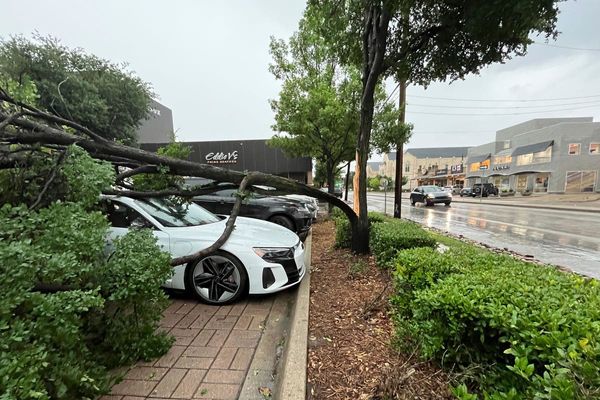
At first, even as the waters were rising, Viktor Ivankhnenko hoped the one-storey home he had built on a Russian-occupied island in the Dnipro River would be safe. But as day wore into night, it became clear his optimism was misplaced.
By 3am on Wednesday, Viktor, 66, and his wife, Nadiia, knew it was time to leave. Packing up what possessions they could, they got into a boat and paddled desperately to a neighbour’s two-storey house as the waters enveloped their own.

Reaching out his right hand, he showed off a burst blister from the effort – and then he described the fate of his home. “It’s underwater, completely underwater. Well, just the chimney is above, just the chimney,” he said.
Rescuers had brought the couple to Kherson by boat on Wednesday lunchtime, delivering them to a makeshift port that before the flooding was a nondescript urban crossroads. On Monday it had been 500 metres from the banks of the river, but then the dam upstream at Nova Kakhovka had burst.
Their home on Potemkin Island was “in the grey zone”, Nadiia said, a contested area in the river delta where fighting has been largely unreported. The nearest troops were Russian and fled on Tuesday, Viktor said, their positions presumably lost to the flood water.
For a man who may have lost his house, Viktor was astonishingly cheerful, partly because the flooding had prompted his liberation – and a chance to reunite with his family in Kherson. After months of being cut off, he said, “I feel reborn,” glad to be back in Ukrainian-controlled territory and looking forward to living with his son in the city “on the ninth floor”.
Ukrainians in Kherson said it had been possible to rescue people from Russian-held areas on the islands, such as Viktor and Nadiia, and even across the river, because the invaders had had to retreat to avoid the flood. There were rumours that Russian artillery had been forced back too.

The port in the street is about 1.5 miles (2.5km) from the pre-flood frontline, and those who enter Kherson know it has been at risk from merciless Russian shelling. Two police officers were injured on Tuesday when another rescue point was hit but on Wednesday it was peaceful at lunchtime as the evacuation effort went ahead.
It is far too soon be sure about the shelling risk in Kherson but, as Viktor’s story demonstrates, suddenly the frontlines in the 15-month conflict have been changed amid the humanitarian and environmental catastrophe unleashed by the dramatic breach of the dam.
At the crossroads turned rescue point, the water levels were still rising, though more slowly than on Tuesday. The water had moved about 200 metres inland overnight and was chest high on the far side of the crossroads. Nevertheless, some were determined to cross through the muddy, grubby, oil-stained water.

Larysa Musian, a hydrologist, who had been present nearby the day before, continued to carry out measuring work. She said the water was now rising 2cm every half an hour, slower than Tuesday’s 6-8cm, and she thought the waters were nearing their peak, 32 hours after the dam burst.
“When it goes down, it will go down much slower than it arrived,” she said, and she began to warn of the immediate environmental impacts – “so much bacteria, garbage, soil,” which would dirty and ruin the low-lying flats and houses already underwater – meaning a long cleanup that could only be imagined on the second day of the flood.

If on the first day many Kherson residents were stunned by what had happened, on the second a more focused response emerged, with civil defence teams running rescue missions and a distinctive Sherp all-terrain vehicle, with its 1.5-metre (5ft) wheels, waiting to drive through the water.
Rescuers were picking up people from the first floors of apartment buildings and from rooftops as a small flotilla of inflatable and other boats headed out to help. They rescued dozens of cats and dogs, the latter continuously barking in the background. Several people refused to be rescued unless their pets could be brought with them.
There were moments of grief amid the rescue, but the prevailing mood was remarkably practical. Svitlana Plokha and Svitlana Abramovich live in an apartment block around the corner from the temporary port; their apartment block housed 100 people before the war, and 30 live there now, many of whom, like the two women themselves, endured months of Russian occupation before the city’s liberation last November.

The pair head the block’s residents group and spent most of Tuesday helping people who live on the ground floor to move out. “The water was this much,” said Plokha, pointing to her lower chest, and they assisted those who could join relatives nearby, persuading the reluctant to leave if necessary, and helping with evacuations to farther afield for those with no alternative.
Both stressed the importance of resilience, arguing that if they could survive the Russian occupation, they could endure anything. “Everyone got together when the invasion started,” Plokha said, describing the self-help mood in their block. “We are strong, we are resistant,” she added, before Abramovich cut in: “And we cannot escape.”
What she meant was that there was no choice but to carry on.







